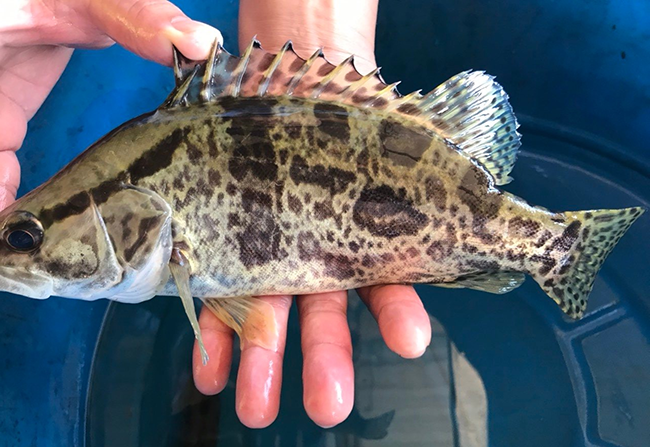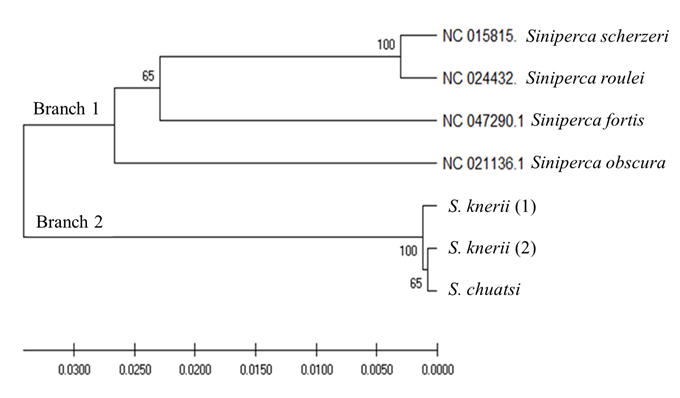The sinipercid fishes (perch fish) belong to a group of lower percoid fishes distributed only in East Asia. The sinipercid fishes, consisting of three genera and twelve species, are endemic freshwater fish in East Asia (Zhou et al., 1988). Interspecific and intergeneric morphological differences and phylogenetic relationship are an important research subject in studies about adaptation and evolutionary biology of freshwater fishes in East Asia (Zhao et al., 2006; Cao et al., 2021). It was known that geographical isolation and a high number of ecological niches are one of the factors leading to formation and divergence (Cao et al., 2021; Zhao et al., 2006). Zhou et al. (1988) proposed that these species have been divided into three genera, Siniperca, Coreoperca, and Coreosiniperca, based on some skeletal characteristics and LDH isozyme pattern. It was reported that Siniperca chuatsi, S. knerii, and S. scherzeri are three major species in Sinipercinae (Chen et al., 2012). Increased demand for production of these species has accelerated extensive aquaculture of them. Using the morphological and skeletal comparison and ecological adaptability of sinipercine fishes, Cao et al. (2021) revealed that the morphological differences between S. chuatsi and S. knerii are closely related to the spatial position of skeleton. This indicated that phenotypic differences have reflected the ecological adaptation of these species to different natural environments. Other previous molecular studies greatly provided the interrelationships among major clades of the Sinipercidae based on mitochondrial DNA gene sequence, interspecific relationship among specious produced controversial results (Chen et al., 2007; Chen et al., 2010; Li et al., 2010; Chen et al., 2012). Among those studies, it was confirmed there was a sister relationship between S. chuatsi and S. kneri, whereas the other relationships were either inconsistent or having low support (Chen et al., 2007; Chen et al., 2010; Li et al., 2010; Chen et al., 2012).
The sinipercids are a group of fresh water perciform fish endemic in East Asia, but widely distributed in Southern China, next to the Northern mountainous area of Vietnam. Thus, this has stimulated us an interesting group for biogeographic studies on freshwater fish fauna in Vietnam. However, more problem challenging systematics of the sinipercids is that the species limits remain still unclear in Vietnam’s Northern mountains.
It was well-known that fish has provided an importantly natural resource as a health food because several species have been identified as rich in easily digestible protein containing all the essential amino acids, therapeutically important polyunsaturated fatty acids, in addition to calcium, iodine, vitamins, and many other nutrients (González et al., 2006; Petricorena, 2015). It was considered that climate change might negatively affect marine fisheries and aquaculture in the coming years. This has led to changes in feeding behavior, food intake, and the chemical composition of fishes (He et al., 2013). Although there are intensive research efforts on feeding behavior, food intake, some qualitative properties of common fish from the different aquatic environments, and chemical composition of fish and fishery products (González et al., 2006; Morton et al., 2006; Petricorena, 2015), there is a lack of information on chemical composition of these species. Taking these into account, the study aimed to investigate the number of the species and their relationship belonging to the sinipercid fishes presented in Vietnam using genetic sequence analysis. In addition, an important issue of this study is to determine the nutritional composition of the species investigated in the Northern mountainous area of Vietnam. The current study may provide useful information on the species and their relationship presented in Vietnam and their chemical composition values, stimulating the aquaculture industry to increase perch production to satisfy regional demand.
    |
 |
| Figure 1. The sinipercid fish |
    |
 |
| Figure 2. Diagram of the genetic relationships between two species, S. chuatsi and S. kneri, and the others of the genus Siniperca |
The results of species identified by molecular markers of 45 samples of the sinipercids obtained showed that 25/45 samples (55.6%) were Siniperca knerii species, and 20/45 samples (44.4%) were Siniperca chuatsi species. The results of chemical composition of these species showed that they contained all essential amino acids. Lipids and proteins were the main source of these species; in addition, they were rich of omega-3 and -6 fatty acids. This study confirmed that there are two species, S. chuatsi and S. kneri, belonging to the genus Siniperca in Vietnam. Preliminary investigations also provided useful information on the basic chemical composition of the sinipercid fishes for development and promotion of aquaculture.
References
Bochert, R., Bernolle, D. & Grunow, B. (2023). Comparison of fatty acid composition of the eggs of wild and farmed Coregonus maraena and the influence of feed. Fisheries and Aquatic Life, 31, 1–14. https://doi.org/10.2478/aopf-2023-0001.
Cao, X.Y., Zhao, J.L., Li, C.H., Zhu, S.Q., Hao, Y.Y., Cheng, Y.M. & Wu, H.Y. (2021) Morphological and skeletal comparison and ecological adaptability of Mandarin fish Siniperca chuatsi and big-eye Mandarin fish Siniperca kneri. Aquaculture and Fisheries, 6: 455–464. https://doi.org/10.1016/j.aaf.2020.04.007.
Chen, D., Guo, X. & Nie, P. (2010). Phylogenetic studies of sinipercid fish (Perciformes: Sinipercidae) based on multiple genes, with first application of an immune-related gene, the virus-induced protein (viperin) gene. Molecular Phylogenetics and Evolution, 55: 1167–1176. https://doi.org/10.1016/j.ympev.2010.01.039.
Chen, D. L., Guo, X. G. & Nie, P. (2007). Non-monophyly of fish in the Sinipercidae (Perciformes) as inferred from cytochrome b gene. Hydrobiologia, 583:77–89. https://doi.org/10.1007/s10750-006-0478-4.
Chen, D-X., Chu, W-Y., Liu, X-L., Nong, X-X., Li, Y-L., Du, S-J. & Zhang, J-S. (2011). Phylogenetic studies of three sinipercid fishes (Perciformes: Sinipercidae) based on complete mitochondrial DNA sequences. Mitochondrial DNA, 23 (2): 70-76. https://doi.org/10.3109/19401736.2011.653799.
Zhao, J-L., Wang, W-W., Li, S-F. & Cai, W-Q. (2006). Structure of the mitochondrial DNA control region of the sinipercine fishes and their phylogenetic relationship. Acta Genetica Sinica, 33: 793-799. https://doi.org/10.1016/S0379-4172(06)60112-1.
Li, C., Ortí, G. & Zhao, J. (2010). The phylogenetic placement of sinipercid fishes ("Perciformes'') revealed by 11 nuclear loci. Molecular Phylogenetics and Evolution, 56: 1096–1104. https://doi.org/10.1016/j.ympev.2010.05.017.
Song, S., Zhao, J. & Li, C. (2017). Species delimitation and phylogenetic reconstruction of the sinipercids (Perciformes: Sinipercidae) based on target enrichment of thousands of nuclear coding sequences. Molecular Phylogenetics and Evolution, 111: 44-55. https://doi.org/10.1016/j.ympev.2017.03.014.
Zhou, C.W., Yang, Q. & Cai, D.L. (1988). On the classification and distribution of the Sinipercinae fishes (Family Serrani- dae). Zoological Research, 9(2), 113-125.
Vu Thi Hanh - Faculty of Food Science and Technology